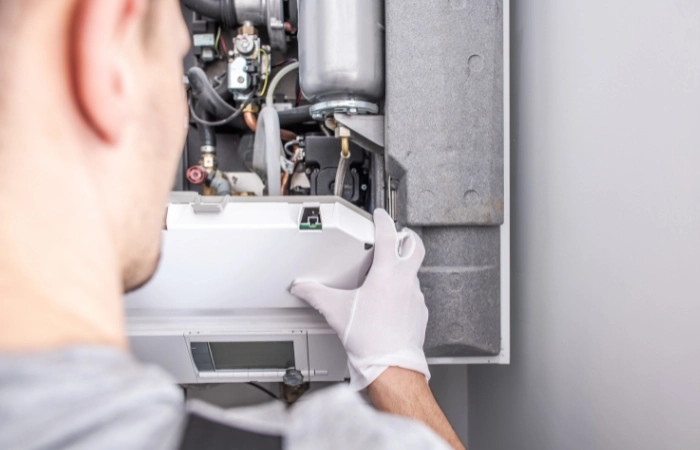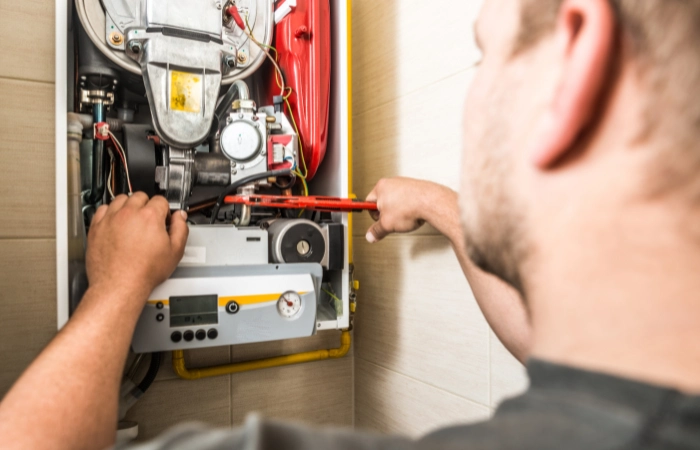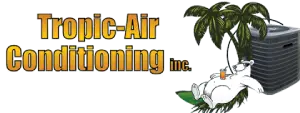As the chill of winter sets in, there’s nothing quite like the comforting warmth of a well-functioning furnace. But did you know that a little proactive furnace maintenance can make a world of difference in keeping your home cozy, your energy bills low, and your furnace running smoothly for years to come? After all, it’s not just about staying warm. It’s mostly about optimizing your system’s efficiency, preventing costly breakdowns, and ensuring a healthy indoor environment.
In this comprehensive guide, we’ll walk you through the top 10 furnace maintenance tips that every homeowner should know.
What Is Furnace Maintenance?
Furnace maintenance is the regular care and upkeep of your heating system to ensure it operates safely, efficiently, and effectively. It is a part of HVAC maintenance that involves a series of tasks, both simple DIY actions and professional inspections, that help prevent breakdowns, extend your furnace’s lifespan, and keep your home warm and comfortable throughout the winter.
Expert Maintenance Tips to Keep Your Home Warm and Cozy All Year Round
Your furnace is a complex system with a lot of moving parts, all working together to keep your home comfortable throughout the winter. While it’s easy to take its reliable operation for granted, neglecting regular maintenance can lead to decreased efficiency, unexpected breakdowns, and even safety hazards. Here are 10 maintenance tips from our experts to keep your home comfortable:
1. Change Your Air Filter Regularly
The air filter is your furnace’s first line of defense against dust, dirt, and allergens. A clogged filter restricts airflow, forcing your furnace to work harder and consume more energy. Not only does this drive up your heating bills, but it can also result in premature wear and tear on your system. Make it a habit to check your filter monthly, especially during peak heating season, and replace it every 1-3 months or as recommended by the system’s manufacturer.
2. Inspect and Clean Vents and Registers
Your vents and registers play a crucial role in distributing warm air throughout your home. When these openings are blocked by dust, pet hair, or other debris, it can create hot and cold spots, reducing comfort and putting additional strain on your furnace. Regularly dusting and vacuuming these areas, along with ensuring furniture or other objects aren’t obstructing them, will help maintain optimal airflow and even heating.
3. Check Your Thermostat
Your thermostat acts as the control center for your heating system. If it’s not calibrated correctly or malfunctions, it can lead to inefficient heating cycles and uncomfortable temperature fluctuations. Double-check that your thermostat is set to your desired temperature, and also consider upgrading to a programmable or smart thermostat. These advanced models can be programmed to adjust temperatures automatically, maximizing energy savings and ensuring a comfortable environment.
4. Keep the Area Around Your Furnace Clear
Your furnace needs space to “breathe” for proper airflow and ventilation. Ensure a clear 3-foot radius around your furnace, free of boxes, storage items, and other clutter. This prevents dust and debris from being sucked into the system and helps maintain a safe distance from flammable materials.
5. Lubricate Moving Parts (if applicable)
Some furnace models have moving parts, such as motor bearings, that require periodic lubrication to reduce friction and wear. Check the manual to determine if your furnace needs lubrication, and follow the manufacturer’s instructions for the appropriate type of lubricant and frequency of application.

6. Clean the Burners and Flame Sensor
Over time, dust and dirt can accumulate on the burners and flame sensor, impacting ignition and combustion efficiency. Carefully clean these components with a soft brush or compressed air, and make sure to follow the manufacturer’s guidelines. This simple task can improve your furnace’s performance and reduce the risk of malfunctions.
7. Check the Blower Motor
The blower motor is what circulates warm air throughout your home. Listen for any unusual/weird noises, such as squealing or grinding, which could indicate a problem. If you notice any issues, it’s crucial to have a professional HVAC technician inspect and address the problem promptly.
8. Inspect the Chimney and Venting System
If your furnace vents through a chimney or other exhaust system, it’s important to ensure it’s clear of obstructions like bird nests, leaves, or debris. A blocked vent can prevent proper exhaust of combustion gasses, creating a dangerous situation. Regular inspection and cleaning are necessary for safe and efficient operation.
9. Schedule Annual Professional Maintenance
While DIY maintenance is essential, a comprehensive inspection and tune-up by a qualified HVAC technician are crucial for optimal furnace performance and longevity. They have the expertise to identify potential issues early on, perform necessary repairs, and make adjustments that maximize efficiency.
10. Don’t Ignore Warning Signs
Your furnace will often give you clues when something isn’t right. Strange noises, uneven heating, frequent cycling on and off, or a weird increase in energy bills can all be signs of an underlying problem. Ignoring these warning signs may lead to costly repairs in the future. If you notice anything unusual, contact an HVAC professional for diagnosis and repair.
Frequently Asked Questions
How often should I have my furnace professionally serviced?
It’s generally recommended to have a professional HVAC technician inspect and service your furnace annually, ideally before the start of the heating season. This ensures optimal performance, catches potential problems early, and helps extend the lifespan of your system.
Can I use a cheaper air filter to save money?
While it might seem tempting to opt for a cheaper air filter, it’s not always the best choice. Cheaper filters often have lower MERV ratings, meaning they don’t capture as many particles and allergens. Investing in a higher-quality filter can improve indoor air quality and protect your furnace from dust and debris buildup.
What are some signs that my furnace might need repair?
Keep an ear out for unusual noises like banging, rattling, or squealing. If your furnace is short-cycling (turning on and off frequently), not producing enough heat, or emitting a burning smell, it’s time to call a professional. Additionally, a sudden increase in energy bills could indicate an underlying issue.
Schedule a Furnace Maintenance Service with Tropic Air Conditioning Today!
A well-maintained furnace is the key to a comfortable and energy-efficient home during the winter months. By following these top 10 maintenance tips, you can extend the life of your furnace, prevent costly breakdowns, and enjoy consistent warmth throughout the season. Remember, regular upkeep is not just a chore – it’s an investment in your comfort and peace of mind.
Ready to give your furnace the care it deserves? Let the experts at Tropic Air Conditioning take the hassle out of furnace maintenance. Our certified technicians have the experience and expertise to ensure your heating system operates at peak performance all year long. To get started, contact us today!




